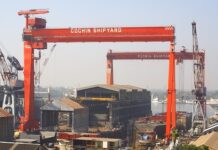
In a recent survey of US export containers the National Cargo Bureau (NCB) found that 38% of containers had misdeclared cargo, according to a White Paper released by the group on 6 July.
According to the NCB inspections of container cargoes have shown a “high degree of non-compliance,” for containers with declared dangerous goods including a high incidence of poor stowage and securing within containers.
“Last year, NCB conducted 32,387 DG container (dry and tank) inspections in the USA and found that 7.9% of these units (equating to 2,569 containers) were non-compliant due to poor stowage/securing; misdeclared cargo or other related issues.”
Around 6.5% of the containers with dangerous goods had misdeclared cargo. Normally the NCB scrutinises import cargo, to the US, but last year it also looked at export containers and the organisation was shocked by what it discovered.
“Interestingly, for dangerous goods containers exported from the USA, the failure rate was 38% which, when compared to the annual average of 7.9% for regular inspections, may be a strong indication that shippers and consolidators are more likely to comply with applicable regulations if there is a reasonable chance their shipment will be inspected,” said the NCB.
Furthermore, the NCB was “startled” to discover that 2.5% of inspected imported dangerous goods containers included misdeclared freight that “represented a serious risk to crew, vessel and the environment”.
If these figures are a representative sample of the total global containerised dangerous cargo shipments it would represent 135,000 container loads of misdeclared cargo.
“When extrapolated to the 5.4million DG [dangerous goods] containers shipped annually, the potential risk to life, vessel, cargo and the environment is unacceptably high and hard to ignore, said the NCB.
Another source of danger was declaring flammable liquids as ‘limited quantities’, which can lead to improper stowage or segregation errors, or the placing of flammable cargo next to ignition sources or in areas of little or no protection.
According to the NCB it has conducted 3,286 dangerous goods compliance reviews over the last three years on behalf of vessel operators. Some 24% of these containers had some type of stowage or segregation error including those related to regulatory requirements and/or the vessel’s document of compliance.
A further 71% of container were discovered to have discrepancies on the vessel’s dangerous cargo manifest, including missing stowage positions, emergency response information, incorrect shipping name or identification number and missing signatures that signify the dangerous cargo manifest had been reviewed and found correct.
As a result of its investigations the NCB White Paper concluded, “The levels of non-compliance observed indicate a system ripe for the type of disasters the industry has experienced over the last several years. This will continue unless a comprehensive holistic approach is adopted by the industry to attack the root of the problem and minimise non-compliance by all supply chain participants.”





